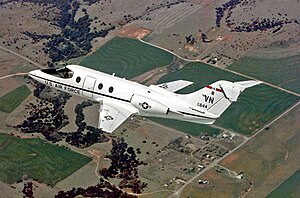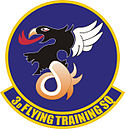3d Aero Squadron
| 3rd Flying Training Squadron | |
|---|---|

T-1A Jayhawk, 3rd Flying Training Squadron
|
|
| Active | 1916–1919; 1919–1946; 1973–1993; 1994–2000; 2001–c. 2011 |
| Country |
|
| Branch |
|
| Role | Pilot Training |
| Engagements | World War II Battle of the Philippines |
| Decorations |
Distinguished Unit Citation Air Force Outstanding Unit Award with Combat "V" Device Philippine Presidential Unit Citation |
| Insignia | |
| 3rd Flying Training Squadron emblem (Modified 18 September 1995) |  |
| 3d Pursuit Squadron emblem (Approved 24 February 1924) |  |
The 3rd Fighter Training Squadron is part of the 71st Operations Group under the 71st Flying Training Wing. It operates the T-1A Jayhawk aircraft conducting advanced phase tanker/transport flight training.
The 3rd FTS is the third-oldest squadron in the Air Force, with over 95 years of service to the nation, its origins date to the organization of the 3rd Aero Squadron on 1 November 1916 at Fort Sam Houston, Texas. Deployed to the Philippines after World War I, during the 1941-1942 Battle of the Philippines, it was wiped out, with some of its personnel being forced by the Japanese to endure the Bataan Death March. It was not re-activated until 1973.
To qualify warriors with the skills and attitude necessary to become the world's best combat airlift and tanker pilots.
The 3d Fighter Training Squadron dates to the organization of the 3d Aero Squadron on 1 November 1916 at Fort Sam Houston, Texas. Most of the officers and men of the Squadron were transferred from the Aviation School at Rockwell Field, San Diego, California, where, at the time, all Army aviators were trained. There, it replaced the 1st Aero Squadron, whose members were sent to Columbus Airfield, New Mexico as part of the Punitive expedition against Pancho Villa. There, the squadron may have operated some Curtiss JN-3s and possibly some Curtiss N-8s, preparing them to be sent south to Columbus.
In December 1916, Congress authorized the lease of a 700-acre tract of land seven miles south of San Antonio, Texas for a new airfield to accommodate the rapidly expanding Aviation Section of the Signal Corps. By March 1917, men from the 3d Aero Squadron were hard at work clearing the cotton plants from the land and laying foundations for hangars and mess halls at what would become Kelly Field. On 5 April 1917, one day before the United States entered World War I, four Curtiss JN-4 "Jennies" landed at the new field.
...
Wikipedia
